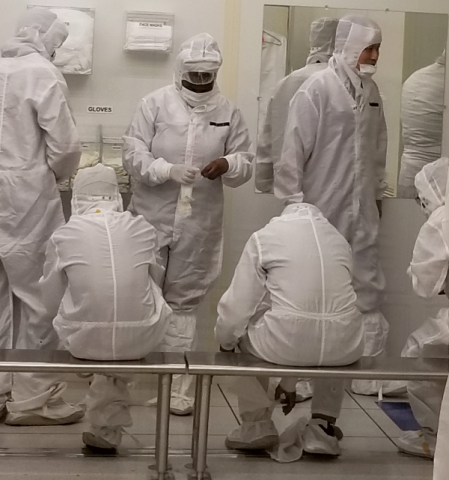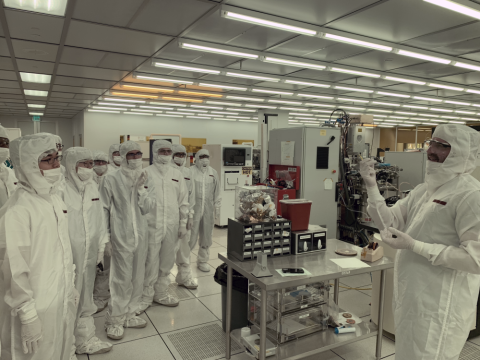STEM outreach events often include a combination of presentation style and hands-on activities, and perhaps a chance to look into a working lab, if the event includes a site visit. On October the 24th, sophomore level students from the Gwinnett School of Mathematics, Science, and Technology (GSMST) got the rare chance to “gown up” and enter the research cleanrooms at the Marcus Nanotechnology Building, home of the Institute for Electronics and Nanotechnology at Georgia Tech. This “gowns-on” approach to outreach was planned by Professors Asif Khan and Azadeh Ansari, both of the School of Electrical and Computer Engineering (ECE), and Ms. Nicole D’Antonio, Partnership & Internship Coordinator at GSMST.
STEM outreach events often include a combination of presentation style and hands-on activities, and perhaps a chance to look into a working lab, if the event includes a site visit. On October the 24th, sophomore level students from the Gwinnett School of Mathematics, Science, and Technology (GSMST) got the rare chance to “gown up” and enter the research cleanrooms at the Marcus Nanotechnology Building, home of the Institute for Electronics and Nanotechnology at Georgia Tech. This “gowns-on” approach to outreach was planned by Professors Asif Khan and Azadeh Ansari, both of the School of Electrical and Computer Engineering (ECE), and Ms. Nicole D’Antonio, Partnership & Internship Coordinator at GSMST.
Prof. Khan gave the welcome note and explained that the brains of our electronic gadgets, the chips, are made in the clean room by showcasing a 300 mm silicon wafer and a video on how sand is transformed into silicon chips. Prof. Ansari gave a brief talk on microelectromechanical systems (MEMS) devices that are used in cell phones for sensing, navigation and communication, followed by Dr. Hang Chen (GT-IEN) who gave tutorial on basic cleanroom safety and environmental protocols and the reasons for “gowning up”. After the lecture portion, the Gwinnett students joined Georgia Tech graduate students Anthony Gaskell, Nujhat Tasneem, and Mingyo Park in the gowning room to suit up and tour the various areas of the cleanroom and fabrication tools.
The event was a winner with the students, as some of their comments made clear. When asked about their favorite part of the site visit there was a definite theme, “…putting on the clean room suits and touching the pure gold…” One student stated, “The best part was going into the clean room looking like I was about to go to space. I had never thought about how clean an environment needs to be so that the chips that go into our phones and computers can be properly processed.” another noted, “The best part of the visit was actually preparing to enter the clean room. I would have never guessed a person would have to wear a lot of protective gear to prevent the releasing of particles in the air.”
The “gowns-on” approach to the STEM outreach was, perhaps, best summed up by this testimonial, “A firsthand experience as to what they do at the school (Georgia Tech) for that field, rather than just a presentation and Q&A (Going inside a clean room!). I personally loved this trip because this experience helps me see my possible future major, and even school!”
Professors Khan and Ansari would also like to thank graduate student Zheng Wang (ECE), who helped with organizing the visit.
IEN is the organizational home for Georgia Tech's professional nanotechnology support team and physical infrastructure, which includes several research buildings and shared user laboratories valued in excess of $400MUS. IEN also enables research for individual Principal Investigators in addition to several fundamental applied research centers, engineered systems laboratories, and strategic research programs. Additionally, Georgia Tech is proud to be the primary location of the Southeastern Nanotechnology Infrastructure Corridor (SENIC), one of the sites in the National Science Foundation’s (NSF) National Nanotechnology Coordinated Infrastructure (NNCI), as well as the home of the NNCI Coordinating Office.
The Gwinnett School of Mathematics, Science, and Technology began in 2007 as a Science, Technology, Engineering, and Mathematics (STEM) charter school. Gwinnett County Public Schools sought to create a new high school with a rigorous, authentic STEM-focused curriculum. The district conducted national research of existing secondary school programs, reviewing curriculum, visiting campuses, and meeting with school leaders. In March of 2006, the Gwinnett County Board of Education approved a charter that allowed for the flexibility in curriculum design and scheduling needed to realize the vision for the school.
Additional Images

